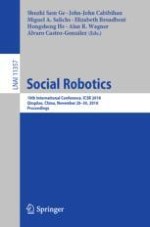2018 | OriginalPaper | Chapter
If Drones Could See: Investigating Evaluations of a Drone with Eyes
Authors : Peter A. M. Ruijten, Raymond H. Cuijpers
Published in: Social Robotics
Publisher: Springer International Publishing
Activate our intelligent search to find suitable subject content or patents.
Select sections of text to find matching patents with Artificial Intelligence. powered by
Select sections of text to find additional relevant content using AI-assisted search. powered by
